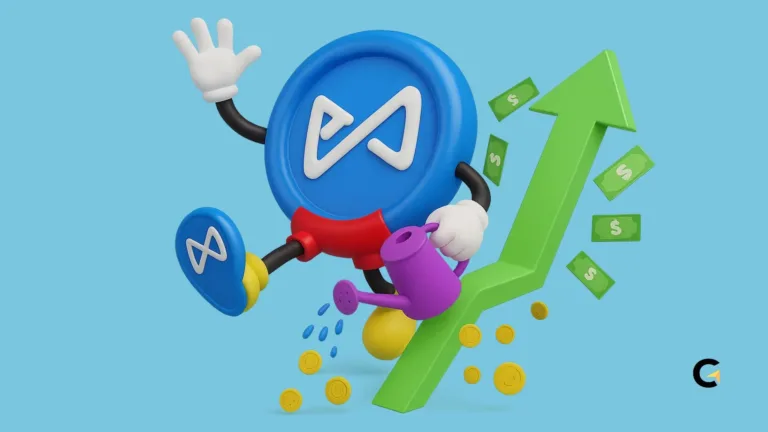Will Polygon Hit $10?
Polygon’s ambition to hit $10 hinges on a complex interplay of innovation, adoption, and market forces.
Some analysts believe that Polygon may not reach the $2 mark by 2025 but could achieve it by 2026. However, there’s no clear consensus on whether the $10 milestone will be reached, though its trajectory may still follow Bitcoin’s market cycle.
Achieving this milestone would require transformative growth in on-chain activity, breakthrough scalability upgrades, and strong institutional support. In this article, we’ll examine all the key factors that could contribute to making it happen.
Key Takeaways:
Hide- Cryptopolitan: Forecasts MATIC at $1.34–$1.57 in 2025, bullish on Layer-2 scaling and Polygon 2.0. (Source: Cryptopolitan)
- CoinCodex: Predicts up to $0.78 in Apr 2025; algorithm factors include volatility and Bitcoin halving. (Source: CoinCodex)
- DigitalCoinPrice: Sees MATIC reaching $2.84 in 2025 and $3.87 in 2026 based on growing DeFi and NFT use. (Source: DigitalCoinPrice)
- Changelly: Projects $2.01 in 2025 and $3.10 in 2026 via ecosystem expansion and partnerships. (Source: Changelly)
- CCN Analysis: Breakout from a descending triangle could yield an 82% surge toward multi-dollar levels. (Source: CCN)
Polygon Price Prediction to Hit $10

In this section, we examine expert forecasts, key catalysts, technical patterns, and fundamental requirements that could drive, or derail, Polygon’s pursuit of a $10 valuation.
By breaking down each element, readers can gauge how realistic this objective is and what to watch moving forward.
Expert Pulse: Forecasts & Sentiments
Analyst predictions for 2025 and beyond paint a mixed picture. Some models foresee Polygon (prev Matic) trading between $0.78 and $1.57 by year-end 2025, driven by Layer-2 adoption and ecosystem growth.
More optimistic projections place MATIC above $2 by 2026 if strategic partnerships and Polygon 2.0 rollouts exceed expectations. Yet algorithmic forecasts remain cautious, reflecting crypto’s volatility and Bitcoin cycle influences.
Catalysts for a $10 Surge
- Technological Edge: Polygon 2.0’s Aggregation Layer and zk-rollups must deliver significant throughput and security improvements, outpacing Arbitrum, Optimism, and zkSync.
- Ecosystem Expansion: Tens of thousands of daily active users, thriving DeFi protocols, NFT marketplaces, and gaming DApps are essential to justify a higher market cap.
- Institutional Adoption: Entry of crypto funds, ETFs, or corporate treasuries into MATIC would inject deep liquidity and market confidence.
- Regulatory Clarity: Favorable rulings on securities classification and on-chain asset regulation would reduce risk premiums and encourage mainstream participation.
- Macro Tailwinds: A sustained bull market in digital assets, buoyed by macroeconomic stability and renewed risk appetite, would provide the backdrop for altcoin rallies.
Technical Analysis: Spotting the Breakout
- Descending Triangle Apex: A confirmed breakout above the triangle’s apex could spark an 82% rally, implying a move from current levels toward mid-single digits. Watch volume spikes for validation.
- Support & Resistance Zones: Holding horizontal support near $0.60–$0.65 is critical. A rebound there suggests renewed buying power; a drop would invalidate the bullish thesis.
- Moving Average Signals: A golden crossover of the 50-day MA above the 200-day MA would signal sustained bullish momentum, often preceding multi-month uptrends.
Fundamental Reality Check
Reaching $10 requires more than chart patterns, it demands a fundamental shift in Polygon’s value proposition:
- Mass Adoption: Millions of daily users, not just thousands, interacting with real-world asset tokenization, DeFi, and NFTs on Polygon.
- Revenue Generation: Consistent fee revenue and staking yield that justify a market capitalization north of $50 billion.
- Network Effects: A self-reinforcing cycle of developers, users, and institutions choosing Polygon over competitors, cementing its role in Ethereum’s scaling landscape.
Best Practices for Targeting $10
In this section, we present best practices to navigate Polygon’s ambitious bid for $10.
These guidelines draw on technical, fundamental, and risk-management insights to help investors and stakeholders align strategies with key success factors.
- Track Upgrade Milestones: Monitor Polygon 2.0 deployment phases and zk-rollup launches to gauge technological progress.
- Evaluate On-Chain Metrics: Focus on daily active addresses, transaction counts, and total value locked (TVL) as leading indicators of adoption.
- Set Technical Alerts: Use breakpoints at $0.77, $1.03, and the descending triangle apex to trigger reassessment of positions.
- Diversify Exposure: Balance MATIC holdings with other Layer-2 tokens to mitigate protocol-specific risks.
- Follow Institutional Flows: Watch for large wallet movements, ETF filings, and fund announcements for signs of deep-pocket interest.
- Stay Updated on Regulation: Keep abreast of jurisdictional rulings affecting token classification and DeFi compliance.
- Stress-Test Scenarios: Model outcomes under bear, base, and bull cases to define clear entry, add-on, and exit strategies.
The Possibility of Polygon to Hit $10
Polygon’s journey to $10 is a high-stakes endeavor that blends technical innovation, ecosystem growth, and market psychology.
Success hinges on flawless execution of Polygon 2.0 upgrades, mass adoption across DeFi, NFTs, and real-world assets, plus robust institutional support underpinned by regulatory clarity.
Technical breakouts above key resistance and golden moving average crossovers would reinforce the bullish case. However, fierce Layer-2 competition and Ethereum’s own scaling upgrades pose existential risks.
In the end, reaching $10 by 2030 remains plausible, but only if Polygon can transform ambition into sustained reality. Price predictions to note: 2025 range of $0.78–$1.57; 2026 up to $3.87; long-term $10 target by 2031.







